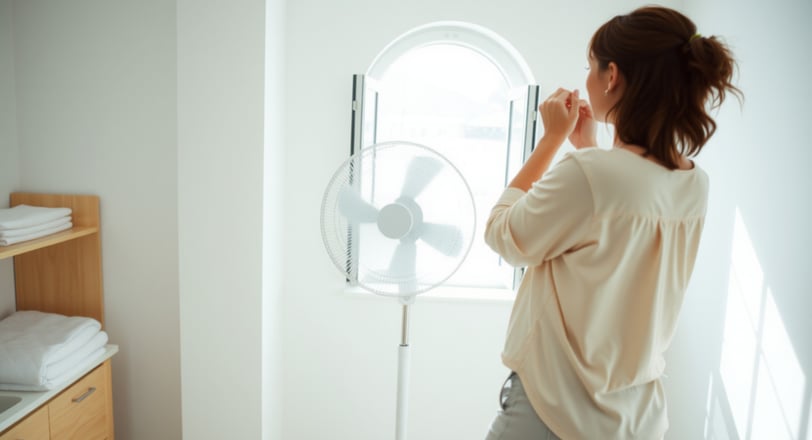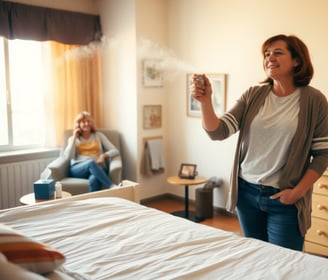
Title: Immediate Odor Control After Diaper Changing: Essential Tips and Best Practices
INCONTINENCE CARE
Effective odor control is not merely a matter of physical cleanliness but also an essential aspect of maintaining the emotional well-being of both caregivers and those in their care. The presence of lingering odors can lead to embarrassment or discomfort, potentially impacting dignity and self-esteem. By addressing these issues promptly and efficiently, we can ensure that daily care activities are not only hygienic but also preserve the confidentiality and respect that every individual deserves.


Introduction
In the realm of home care, managing odors after diaper changes is crucial for maintaining comfort, hygiene, and emotional well-being for everyone involved. It's about more than just preventing smells; it's about preserving dignity and providing a caring environment that respects the individual's privacy and self-worth. Let's explore how to tackle this challenge head-on with practical tips and best practices.
1. Proper Disposal of Used Diapers
The battle against odors begins at the point of disposal. Using an airtight diaper disposal system or bags is your first line of defense, locking in those unwelcome smells from the get-go. Regular trash removal schedules are also non-negotiable, as they prevent odors from accumulating and becoming more potent over time.
1.1 Alternative Disposal Methods:
For an extra touch of freshness, you might consider scented trash bags or designating a sealed trash bin outside the main living area to capture those initial whiffs before they spread throughout your home.


2. Cleaning the Area
A clean environment is directly correlated with a pleasant smell. Immediately after each diaper change, it's imperative to disinfect all surfaces. Disposable underpads are a game-changer for catching leaks and odors on contact, making cleanup a breeze and your living space much more hospitable.
2.1 Deep Cleaning Routine:
Don't forget the importance of a regular deep cleaning schedule—mopping floors, washing bed linens, and sanitizing all touchpoints to ensure that odors don't linger or become ingrained in your environment over time.
3. Ventilation
Fresh air is a natural ally against odors. Open windows or use fans to encourage the circulation of fresh air throughout the room. For an added layer of defense, consider equipping the space with an air purifier featuring an activated carbon filter—these are designed specifically to neutralize and eliminate even the toughest smells.


4. Personal Hygiene
Handwashing is a critical step in maintaining cleanliness and preventing the spread of bacteria. It's equally important for caregivers to use gloves during diaper changes to minimize direct contact with odors and potential irritants. For the individual, skin cleansers and odor-control creams can help neutralize smells and soothe sensitive skin. Moisturizing after each cleanse is also essential to maintain the skin's natural balance and prevent dryness or discomfort.
5. Using Deodorizers
Deploying deodorizers can work wonders for masking any residual odors. Whether it's a room spray, an odor-absorbing product like baking soda or charcoal, or a natural solution with essential oils, these methods can help keep your living space smelling fresh and clean.
5.1. Natural Deodorizing Options:
For those who prefer a more holistic approach to home care, consider using a diffuser with essential oil blends known for their deodorizing properties or crafting homemade odor eliminators using ingredients like baking soda and your choice of fragrant oils.


6. Preventative Measures
Staying ahead of the game is key to managing odors effectively. Odor-neutralizing pads or liners inside the diaper can absorb and neutralize smells at the source, while encouraging regular bathroom use can reduce the frequency of diaper changes and, consequently, the potential for strong odors.
7. Is an Adult Diaper Disposal System Worth It?
Investing in a high-quality adult diaper disposal system can be a game-changer for caregivers managing frequent changes, especially in shared living spaces.
Summary
Incorporating the strategies discussed here can significantly improve the quality of life for both caregivers and those receiving care. By implementing these tips and best practices, we can create a fresher, more comfortable home environment that respects the dignity of every individual involved. Embrace these methods to enhance your caregiving experience while maintaining the highest standards of cleanliness and comfort.
Related Article
More for you



